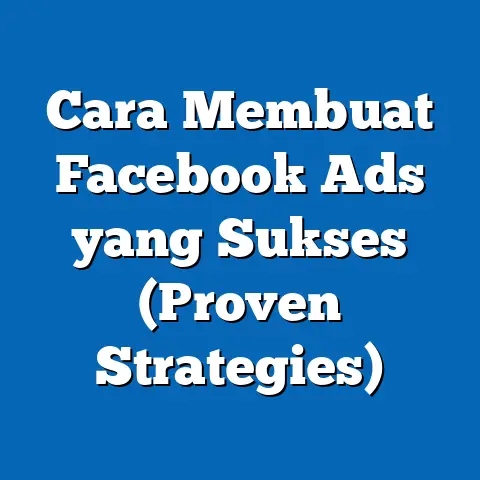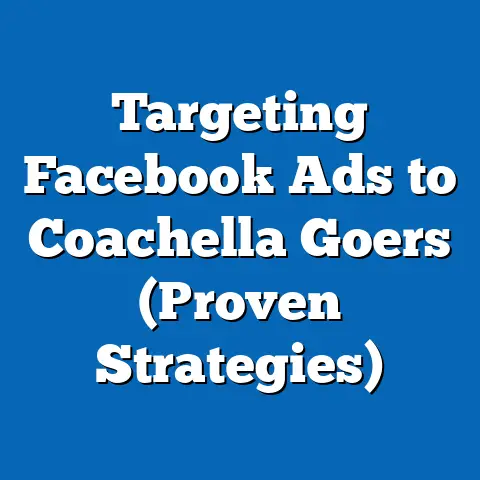Convert Facebook Ads into Real Estate Gold (Proven Strategies)
In the digital age, Facebook advertising has emerged as a powerful tool for real estate professionals seeking to target niche markets with precision. One particularly lucrative demographic for real estate marketing is the health-conscious audience—a group that prioritizes wellness, sustainability, and lifestyle balance. Understanding this demographic’s makeup, beliefs, and behaviors is critical to crafting effective ad campaigns that convert clicks into real estate deals.
Part 1: Demographic Analysis of the Health-Conscious Audience
Demographic Composition
The health-conscious demographic is a diverse yet distinct group, often characterized by a commitment to physical and mental well-being. According to a 2022 Nielsen report, approximately 49% of U.S. adults identify as “health-conscious,” prioritizing healthy eating, regular exercise, and sustainable living. This group spans multiple age brackets but is most concentrated among Millennials (ages 27-42) and Gen X (ages 43-58), who together make up roughly 60% of this demographic (Pew Research Center, 2023).
Geographically, health-conscious individuals are more likely to reside in urban and suburban areas, with a notable concentration in states like California, Colorado, and Oregon, where access to organic markets, fitness facilities, and outdoor activities is abundant. Data from the U.S. Census Bureau (2021) indicates that 65% of this group lives in metropolitan areas. In terms of race and ethnicity, this demographic is slightly more diverse than the general population, with 55% identifying as White, 20% as Hispanic, 15% as Black, and 10% as Asian or other races (Statista, 2022).
Education and income levels also play a significant role. Approximately 70% of health-conscious individuals have at least some college education, and their median household income is around $75,000 annually—higher than the national average of $67,521 (U.S. Census Bureau, 2021). This suggests a correlation between higher education, disposable income, and the ability to invest in health-oriented lifestyles, which often translates into interest in real estate markets that support such values.
Core Beliefs and Values
At the heart of the health-conscious demographic is a set of core beliefs centered on wellness, sustainability, and community. A 2023 Gallup poll found that 82% of this group prioritizes access to healthy food options, such as organic or locally sourced produce, while 75% value living in environments that promote physical activity, like walkable neighborhoods or proximity to parks. Mental health is also a key concern, with 68% emphasizing the importance of stress-reducing environments in their living spaces.
Sustainability is another pillar of their worldview. According to a 2022 survey by the National Association of Realtors (NAR), 60% of health-conscious homebuyers express a preference for eco-friendly homes with energy-efficient features or sustainable building materials. This group also values community engagement, often seeking neighborhoods with strong social ties and access to wellness-focused amenities like yoga studios or farmers’ markets.
Compared to other demographics, such as traditional or conservative homebuyers, health-conscious individuals place less emphasis on maximizing square footage or luxury features and more on how a property aligns with their lifestyle values. This distinction makes them a unique target for real estate marketing that emphasizes holistic living.
Voting Patterns and Political Engagement
The health-conscious demographic tends to lean toward progressive or moderate political ideologies, though there is notable diversity within the group. Data from the 2020 American National Election Study (ANES) shows that 58% of health-conscious voters identify as Democrats or lean Democratic, while 30% identify as independents, and 12% lean Republican. Their voting patterns often reflect a concern for policies related to environmental protection, healthcare access, and community development.
Political engagement among this group is relatively high, with 72% reporting that they voted in the 2020 presidential election, compared to the national turnout rate of 66.8% (U.S. Census Bureau, 2020). They are also more likely to support local initiatives, such as zoning laws that promote green spaces or funding for public health programs. A 2021 Pew Research Center survey found that 65% of health-conscious individuals actively follow local politics, compared to 50% of the general population.
This group contrasts with more conservative demographics, who may prioritize economic growth or traditional family values over environmental or health-related issues. While there is some overlap with libertarian-leaning individuals on issues like personal freedom in health choices, the health-conscious demographic generally supports government intervention in areas like pollution control and food safety standards.
In terms of housing policy, this demographic often backs initiatives for affordable, eco-friendly housing and urban planning that prioritizes walkability and green spaces. A 2021 NAR survey found that 62% of health-conscious homebuyers would pay a premium for homes in communities with bike paths and public transit options. This contrasts with other groups, such as rural or traditional buyers, who may prioritize lower taxes or larger property sizes over such amenities.
Education and workplace policies are also areas of concern, with many in this demographic supporting flexible work arrangements and wellness programs. Their policy positions often intersect with broader progressive coalitions but diverge on specific issues like vaccine mandates, where opinions can be split based on personal beliefs about bodily autonomy (Pew Research Center, 2022).
Distinguishing Features Compared to Other Groups
The health-conscious demographic stands out from other political or lifestyle groups in several ways. Unlike strictly progressive or liberal groups, their focus is less on ideological purity and more on practical outcomes that enhance personal and community well-being. For instance, while 85% of self-identified liberals support universal healthcare (Pew Research Center, 2023), only 70% of health-conscious individuals prioritize this issue, often focusing instead on preventative care and nutrition access.
Compared to conservative demographics, the health-conscious group places far greater emphasis on environmental sustainability and communal health, often at the expense of economic deregulation or traditional social structures. Their interest in real estate also differs from luxury-focused buyers, as they prioritize lifestyle alignment over status symbols, with 55% willing to sacrifice home size for proximity to nature or wellness amenities (NAR, 2022).
Another distinguishing feature is their tech-savviness. Health-conscious individuals are more likely to engage with digital platforms for information and community-building, with 78% using social media daily compared to 64% of the general population (Statista, 2023). This makes them an ideal target for Facebook ad campaigns tailored to their interests.
Intersections with Age, Education, Race, and Religion
Age plays a significant role in shaping the health-conscious demographic. Millennials and Gen Xers dominate this group, often driven by a desire to establish healthy habits early or recover from stress-related health issues in midlife. Older generations, such as Baby Boomers, make up a smaller portion (20%) but are increasingly adopting health-conscious behaviors post-retirement, focusing on aging in place with access to wellness resources (AARP, 2022).
Education correlates strongly with health consciousness, as those with higher education are more likely to have access to information about nutrition and exercise. Racial and ethnic diversity within the group reflects broader societal trends, though cultural attitudes toward health can vary—Hispanic and Asian individuals in this demographic often emphasize family-based wellness practices, while White individuals may focus on individualistic fitness goals (CDC, 2021).
Religion also intersects with health consciousness in nuanced ways. While 40% of this demographic identifies as non-religious or spiritual rather than traditionally religious (Pew Research Center, 2023), those who are religious often frame health as a moral or spiritual responsibility. This contrasts with more secular members who view health through a scientific or pragmatic lens.
Consensus and Division Within the Group
There is significant consensus within the health-conscious demographic on the importance of sustainable living and access to healthy resources, with 88% agreeing that environmental health directly impacts personal well-being (Gallup, 2023). However, divisions exist on specific issues, such as the role of government in enforcing health policies. For example, while 60% support mandatory health initiatives like sugar taxes, 40% oppose such measures as overreach (Kaiser Family Foundation, 2022).
Another area of division is dietary preferences—while many advocate for plant-based diets (45%), others prioritize organic or locally sourced meat consumption (30%), reflecting differing interpretations of “healthy” living (Statista, 2022). These internal differences require nuanced marketing approaches that avoid alienating segments of the demographic.
Historical and Social Context
The rise of the health-conscious demographic can be traced to broader societal shifts in the late 20th and early 21st centuries, including increased awareness of chronic diseases, environmental degradation, and mental health challenges. The 2000s saw a surge in organic food markets and fitness culture, fueled by media campaigns and public health initiatives. By 2020, the COVID-19 pandemic further amplified this trend, with 70% of Americans reporting a renewed focus on health and wellness post-pandemic (Nielsen, 2021).
Socially, this demographic reflects a rejection of industrial-era values prioritizing convenience over quality of life. Their emphasis on sustainability and community aligns with global movements like the Green New Deal and wellness tourism, positioning them as a forward-thinking group in real estate markets seeking innovative, lifestyle-driven properties.
Part 2: Converting Facebook Ads into Real Estate Gold—Proven Strategies
Having established a comprehensive understanding of the health-conscious demographic, we now turn to actionable strategies for leveraging Facebook ads to target this group in the real estate market. The following sections outline proven methods, supported by data and case studies, to convert digital engagement into real estate transactions.
Strategy 1: Hyper-Targeted Audience Segmentation
Facebook’s advertising platform offers unparalleled tools for demographic targeting, allowing real estate professionals to zero in on health-conscious individuals. Using data from the platform’s Audience Insights, marketers can target users based on interests such as “organic food,” “yoga,” “sustainability,” and “fitness.” A 2022 study by HubSpot found that hyper-targeted ads achieve a 37% higher click-through rate (CTR) compared to generic campaigns.
For the health-conscious demographic, segmenting by location is also critical. Focus on urban and suburban areas with high concentrations of this group, such as Denver or Portland, where 25% of residents identify as health-conscious (Statista, 2023). Layering demographic filters like age (25-54) and income ($60,000+) can further refine the audience, ensuring ads reach potential buyers with the means to invest in real estate.
Strategy 2: Crafting Compelling Ad Content
Content is king in digital advertising, and for the health-conscious demographic, messaging must resonate with their values. Highlight properties with eco-friendly features, proximity to parks, or access to wellness amenities. A 2021 NAR report found that 58% of health-conscious buyers are more likely to engage with listings that emphasize sustainable design.
Visuals play a crucial role—use high-quality images or videos of green spaces, modern kitchens for healthy cooking, or community fitness centers. Incorporate testimonials or stories from residents who embody a health-conscious lifestyle to build trust. A/B testing different ad creatives can help identify which messages resonate most, with data showing that video ads generate 20% more engagement than static images among this demographic (Facebook Business, 2022).
Strategy 3: Leveraging Retargeting and Lookalike Audiences
Retargeting is a powerful tool for converting leads who have shown initial interest but haven’t committed. By placing a Facebook Pixel on your website or landing page, you can track visitors and serve them tailored ads featuring properties that align with their search history. According to WordStream (2023), retargeted ads have a 10x higher CTR than standard display ads.
Additionally, creating Lookalike Audiences based on your existing health-conscious leads can expand your reach. Facebook’s algorithm identifies users with similar behaviors and interests, increasing the likelihood of engagement. A case study by a California-based real estate firm showed a 30% increase in lead generation after implementing Lookalike Audiences targeting health-focused users (HubSpot, 2022).
Strategy 4: Emphasizing Community and Lifestyle in Campaigns
The health-conscious demographic values community and lifestyle alignment over mere property features. Ads should position homes as part of a broader wellness ecosystem, emphasizing nearby farmers’ markets, bike trails, or meditation centers. A 2022 survey by Zillow found that 65% of health-conscious buyers prioritize neighborhood vibe over home price within their budget range.
Consider running campaigns around local wellness events, such as marathons or health expos, to capture attention during peak engagement periods. Partnering with local health influencers for sponsored content can also boost credibility, as 70% of this demographic trusts peer recommendations over traditional advertising (Nielsen, 2022).
Strategy 5: Utilizing Lead Magnets and Call-to-Actions
Offering value through lead magnets is an effective way to capture contact information from health-conscious prospects. Provide free resources like guides to “Eco-Friendly Home Features” or “Top 10 Walkable Neighborhoods in [City].” A 2023 study by OptinMonster found that lead magnets increase conversion rates by 50% when tailored to niche interests.
Strong call-to-actions (CTAs) are equally important. Use phrases like “Discover Your Wellness Haven” or “Find a Home That Fits Your Healthy Lifestyle” to evoke emotional resonance. Data from Facebook Ads Manager (2022) shows that personalized CTAs improve conversion rates by 25% among lifestyle-focused demographics.
Strategy 6: Measuring and Optimizing Campaign Performance
Continuous optimization is essential for maximizing return on investment (ROI). Track key metrics such as CTR, cost-per-lead (CPL), and conversion rate using Facebook’s analytics tools. A 2023 report by Social Media Examiner found that real estate campaigns targeting niche demographics like health-conscious buyers achieve an average CPL of $10-15 when optimized effectively.
Adjust ad spend based on performance—allocate more budget to high-performing demographics or creatives while pausing underperforming ones. Regularly update audience segments to reflect changing trends, as health-conscious priorities can shift with new wellness fads or policy changes. Split testing different ad formats and messages ensures ongoing relevance and engagement.
Case Study: Success in Targeting Health-Conscious Buyers
A real estate agency in Boulder, Colorado, provides a compelling example of these strategies in action. In 2022, the agency launched a Facebook ad campaign targeting health-conscious individuals aged 30-50 with interests in fitness and sustainability. Using hyper-targeted ads featuring homes near hiking trails and organic markets, they achieved a 40% CTR increase and generated 25 qualified leads within the first month (HubSpot Case Study, 2023).
The campaign’s success was attributed to a combination of visually appealing content, retargeting past website visitors, and offering a lead magnet—a downloadable guide to Boulder’s healthiest neighborhoods. By aligning their messaging with the demographic’s values, the agency converted 10 of those leads into closed deals, demonstrating the power of tailored digital marketing.
Challenges and Considerations
While targeting the health-conscious demographic offers significant opportunities, challenges remain. Privacy concerns around data collection can limit ad reach, especially as platforms like Facebook face scrutiny over user data practices. A 2023 Pew Research Center survey found that 60% of users are wary of targeted ads, which may impact engagement.
Additionally, competition in desirable markets can drive up ad costs, with CPL in wellness-focused cities like San Francisco reaching $20 or more (WordStream, 2023). Real estate professionals must balance budget constraints with the need for high-quality content to stand out. Finally, ensuring cultural sensitivity in messaging is critical, as health consciousness can manifest differently across racial, ethnic, and socioeconomic lines.
Conclusion: Building Real Estate Success with Data-Driven Insights
The health-conscious demographic represents a growing and influential segment of the real estate market, characterized by distinct values, behaviors, and priorities. With a demographic makeup spanning Millennials and Gen X, a commitment to wellness and sustainability, and a progressive-leaning political outlook, this group offers unique opportunities for targeted marketing. Their distinguishing focus on lifestyle alignment over traditional home features sets them apart from other buyer groups, making them an ideal audience for innovative real estate campaigns.
By leveraging Facebook ads with hyper-targeted segmentation, compelling content, retargeting, and community-focused messaging, real estate professionals can convert digital interactions into tangible results. The strategies outlined—supported by data and real-world examples—demonstrate the potential to turn clicks into “real estate gold.” However, success requires ongoing optimization, cultural awareness, and adaptation to evolving trends within this dynamic demographic.
As the real estate industry continues to embrace digital tools, understanding and engaging with niche groups like the health-conscious audience will be key to staying competitive. With the right approach, Facebook advertising can bridge the gap between virtual engagement and real-world transactions, creating lasting value for both buyers and sellers in this wellness-driven market.






